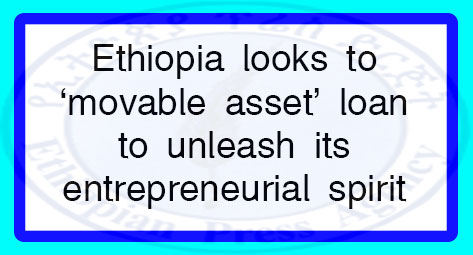
In the past few days, many reports have indicated that Ethiopia is preparing a draft bill whereby banks will take movable assets as collateral for lending. It is expected that the draft bill will help solve the financial constraints citizens, who want to engage in various activities, face due to lack of financial resources.
Tekei Addisu, Economics Lecturer at Addis Ababa University, believes that acceptance of movable assets as security by banks to secure loan widens the chance to get loans, which is a good thing [for local business, and the economy]. Mentioning the fact that collateral is used to reduce asymmetric information problems associated with extending credit, and increase the chances of loan repayment, Tekei points out that it was not allowed previously to take out loan using movable assets as collateral.
“So, the fact that this move will broaden the range of financing instruments means it is a good and positive thing for the economy. But to see the effect, we should wait for it.” Dr. Atakilt Redda from Kotebe Metropolitan University states that movable assets lending, as opposed to fixed assets lending, is the future. In other countries, for instance, a public servant or someone working in the private sector can get a loan on his mortgage or car as long as their income and credit are high enough.
As the finance system/infrastructures modernizes, the loan process should modernize as well, given that accepting fixed assets [alone] as securities is a backward approach/mentality, he argues. As to him, the acceptance of movable assets as security by banks to secure loan facilities helps stimulate business, as finance is the lifeblood of business, which in turn will help spur economic growth, job creation and investment.
Both agree that Ethiopia should look to setup a stronger secured transactions laws to track the movable assets. This will allow the lender to make sure that their applicants’ collaterals are not transferred to a third party, or used for more than one loan application. “Using movable assets to secure bank loans brings both advantages and risks, but the advantage far outweighs the risks,” says Dr. Atakilt. Making Ethiopia leading hub of light industries With nothing to offer for collateral, small and medium-sized businesses and industries are shut out of the credit market.
And according to Wondaferahu Mulugeta, Economics Associate Professor at Meles Zenawi Leadership Academy, lack of access to finance is one of the major problems facing the country’s small-scale and medium industries and entrepreneurs. “Experience shows us that many countries, including Ghana, China, and Vietnam setup a movable asset loan system in a legal framework to bypass this issue.” So, approving movable assets such as cars, agricultural equipment, and even agricultural products as collateral for lending means affording an easier gateway to business opportunities to the country’s small and medium scale industries and entrepreneurs, which is a good thing/ approach, he opines.
The government has put priority on its GTP II plan to make the country a leading hub of light (small and medium scale) industries, where for most; lack of capital has been the missing key ingredient to turn their ideas into a reality. Going further, Wondaferahu says: “There are ideas within small-scale entrepreneurs, but, given that we are a developing country, most of our financial institutions are risk-averse.”
The credit system here is collateral based. So, allowing for movable assets as collateral is a good alternative, and a good opportunity for the country’s aspirations of becoming a leading light industries manufacturing hub in Africa and among the leading countries. In this regard, Ashenafi Melese, Director of Communications at Federal Small and Medium Manufacturing Industry Development Agency, believes that movable asset lending will facilitate the sector’s growth, given that working capital is blood to small and medium businesses.
The type of assets small and medium were asked as collateral are usually high value fixed assets, which caused them difficulty as most of them do not own such collaterals. “Although there are no problems in getting capital goods’ financing service, as they can use the machine as collateral, getting access to working capital is a different story.” Further, Ashenafi indicates that there are some gaps in terms of entrepreneurial mindset, where agrarian attitude reigns over manufacturing, which is not surprising given that 85 percent of the population are engaged in agricultural production.
And a scheme which makes access to finance easier can go a long way in changing this culture, he explains. “What the government should do in this regard is make the public, especially potential entrepreneurs, aware of the opportunities that exist in getting access to capital and unleashing their entrepreneurial potential.” Risk Minimization/Management Movable assets are considered as high risk securities in the banking world.
So, in order to minimize and better manage the risk they pose, Dr. Wondaferahu suggests setting up a code to a movable asset to setup a secured transaction register so that any asset pledged against a loan cannot be mortgaged to a third party. The other thing he recommends is involving countries that have stakes and want our semi-processed products to provide loan guarantee to local banks so that they can offer more loans to small and medium-sized businesses.
Just like the one the loan portfolio guarantee agreement USAID and SIDA made with Enat Bank, which ‘guarantees up to 50 percent of losses on 10 million USD in loans, allowing the Bank to offer more loans to women entrepreneurs and expanding its capacity to lend to small and medium-sized businesses.’ Another one is to provide training to borrowers to augment their productivity so that they can produce more, and lower the default rate. “I see these three options as good risk minimization mechanisms.” Further, he refers on the need of having an effective monitoring mechanism that makes sure that the movables pledged as security at the time of granting the loan are intact.
The Ethiopian Herald, March 13/2019
BY ROBEL YOHANNES





